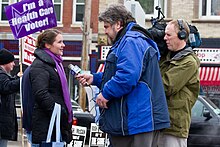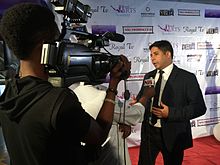
Back Onderhoud Afrikaans Gemaðel ANG مقابلة Arabic Müsahibə Azerbaijani Интервю Bulgarian Intervju BS Entrevista Catalan Interview Czech Interview German Συνέντευξη Greek
| Part of a series on |
| Research |
|---|
 |
| Philosophy portal |





An interview is a structured conversation where one participant asks questions, and the other provides answers.[1] In common parlance, the word "interview" refers to a one-on-one conversation between an interviewer and an interviewee. The interviewer asks questions to which the interviewee responds, usually providing information. That information may be used or provided to other audiences immediately or later. This feature is common to many types of interviews – a job interview or interview with a witness to an event may have no other audience present at the time, but the answers will be later provided to others in the employment or investigative process. An interview may also transfer information in both directions.
Interviews usually take place face-to-face, in person, but the parties may instead be separated geographically, as in videoconferencing or telephone interviews. Interviews almost always involve a spoken conversation between two or more parties, but can also happen between two persons who type their questions and answers.
Interviews can be unstructured, free-wheeling, and open-ended conversations without a predetermined plan or prearranged questions.[2] One form of unstructured interview is a focused interview in which the interviewer consciously and consistently guides the conversation so that the interviewee's responses do not stray from the main research topic or idea.[3] Interviews can also be highly structured conversations in which specific questions occur in a specified order.[4] They can follow diverse formats; for example, in a ladder interview, a respondent's answers typically guide subsequent interviews, with the object being to explore a respondent's subconscious motives.[5][6] Typically the interviewer has some way of recording the information that is gleaned from the interviewee, often by keeping notes with a pencil and paper, or with a video or audio recorder.
The traditionally two-person interview format, sometimes called a one-on-one interview, permits direct questions and follow-ups, which enables an interviewer to better gauge the accuracy and relevance of responses. It is a flexible arrangement in the sense that subsequent questions can be tailored to clarify earlier answers. Further, it eliminates possible distortion due to other parties being present. Interviews have taken on an even more significant role, offering opportunities to showcase not just expertise, but adaptability and strategic thinking.
- ^ Merriam Webster Dictionary, Interview, Dictionary definition, Retrieved February 16, 2016
- ^ Rogers, Carl R. (1945). Frontier Thinking in Guidance. University of California: Science research associates. pp. 105–112. Retrieved March 18, 2015.
- ^ Jamshed, Shazia (September 2014). "Qualitative research method-interviewing and observation". Journal of Basic and Clinical Pharmacy. 5 (4): 87–88. doi:10.4103/0976-0105.141942. ISSN 0976-0105. PMC 4194943. PMID 25316987.
- ^ Kvale & Brinkman. 2008. InterViews, 2nd Edition. Thousand Oaks: SAGE. ISBN 978-0-7619-2542-2
- ^ 2009, Uxmatters, Laddering: A research interview technique for uncovering core values
- ^ "15 Tips on How to Nail a Face-to-Face Interview". blog.pluralsight.com. Archived from the original on 2015-10-11. Retrieved 2015-11-05.